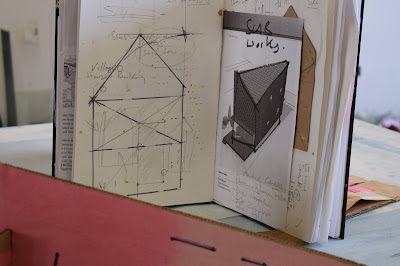Drawings : Work Comes Out Of Work.
Richard Serra
Resultants that incorporate the friction/asperities of their trajectories through medium.
Tilt-up concrete construction, Chapel of St. Ignatius. 1997.
Steven Holl, Parallax.
Braunkreux was a concept, it provided a metaphoric connection between drawing and sculpture.
For Beuys, so-called Braunkreuz was not a colour, it was a generic substance, a sculptural expression. Braunkreuz, being brown, also became a metaphor for the earth as an enveloping cover, a protective medium, a fecund 'body' in which the spirit was reincarnated, as in a womb, a cave, or a grave.
Filtered Light/Coloured Glass Assemblages
Inquiry/Programs/Projects/Spatial agencies that move through speculative material thinking.
Mattering between the division of things.
Intermediaries, sprays, screens, templates, objects.
Drawings/Monoprints/Substance/Materials
Beuys and the language of drawing. 1974.
Beize probably an iron compound in solution, stain or corrosive.
Braunkreuz Oil on cut, folded, and pasted paper, mounted on paper. 65.5x50cm, irregular. 1962.
Beuys spent close to a decade elaborating a personal idiom, doing so almost entirely in drawing.
Joseph Beuys : Life Drawing, Ann Temkin.
Cyanotype
Yellow Ochre
Manganese Dioxide
Red Iron Oxide/Paint
Monochite/White Gesso
Ceramic Forms/SlabWorks
Lead Sheet Constructions, folded and perforated with glass inclusions
Emotion, Space and Society
An Intimate Mode of Looking
Francesca Woodman's Photographs
Jane Simon. 2010
Woodman presents an intimacy between picturing herself and her experiments with the photographic medium. She saw time as persistently liminal.
Whirling space and haptic vision.
Irigaray.
Woodman's body seems to be moving just beyond visibility.
We respond to the experience in the photograph, the inner feeling generated by it.
Indexical Thresholds/Photograms/Wonder/Spaces in which we are drawn outside of ourselves.
The sudden impulse to click the shutter, is at once a work and the record of practice, encompassing both conscious and unconscious awareness.
What is it like to feel oneself disappear into what Foucault called, the space in which we are living, by which we are drawn outside ourselves?
A Swimmer Between Two Words, Michel Foucault. 1998.
Anamorphic perceptions, playing with both space and time, something glimpsed only peripherally and apprehended more than seen, a sense of the ghostly in the everyday and of the slippage between subject and object, and between what is alive and what is inanimate.
Playing with explorations into the gendered nature of the gaze, together with her sophisticated use of buildings and objects and her concern with the properties of photographic space ; place her practice well beyond mere figurations of the female form as always being about the 'woman's body as an icon of desire.
On Identity
Who is the “self” so deceived?
Intermediaries/Devices/Spatial Agency
She uses the mirror and her body as an apparatus, a means of reflecting/diffracting the space she inhabits.
Self-Deceit#6 presents an unusual relationship between woman and mirror. Taken in one of several derelict and abandoned buildings, sites Woodman commonly adopted not only as her studio, but in some cases as her home.
The mirror reflects only glare or darkness, and the figure is consistently blocked by its aggressive reflection of emptiness.
Kathryn Hixson, Essential Magic : The Photographs of Francesca Woodman. 1992.
Francesca Woodman's photographic practice incorporates a variety of themes including gender and self, representation and isolation, the body and its relationship to space, explorations of femininity and the female body.
Throughout her work, Woodman acts as both subject and author, dissolving conventional boundaries of representation.
The textual influences that inspired Woodman are clearly evident in the artist's consequent adoption of certain objects and themes, including mirrors, fur, eels, nudity, all of which hold strong Surrealist associations.
The University of Edinburgh. Camilla Irvine-Fortescue.
Maps of Inner Space, in a swimmer between two worlds.
Katherine Conley. 2008
A deeper reading of her connections to Surrealist practice- at once musical, textual, visual, notational, haptic, physical, and psychic-helps to make her processes clearer.
The haptic quality evoked by Krauss in her writings on surrealist photography is captured by Woodman through her use of black and white and the sensual plethora of greys rendering her textures almost three-dimensional.
Direct Physicality
Man Ray, Anatomies, 1929.
Foucault on automatic writing for Breton.
Woodman's photography went hand-in-hand with her everyday life, her art maintained a constant connection to reality.
Between Flesh and Film. Isabella Pedicini. 2012.
Mattering, Mind-Movement-Material
In and Out of Material. Tony Cragg.
You have to feel the contact of the surfaces and objects photographed with bare skin.
Sloane Rankin.
The suspended/collapsed present moment.
She is unravelling photography's structuring dimensions of space and time.
Un-Framing The Body.
What moves as a body.
Returns as a movement of thought.
Erin Manning.
Relationscapes uncovered/emergent between organism, person, environment.
Mappings and maps whose passage and destinations lie at the edge of perception.
Images and manifestations of the human body that are occurring in between compositional frames.





No comments:
Post a Comment